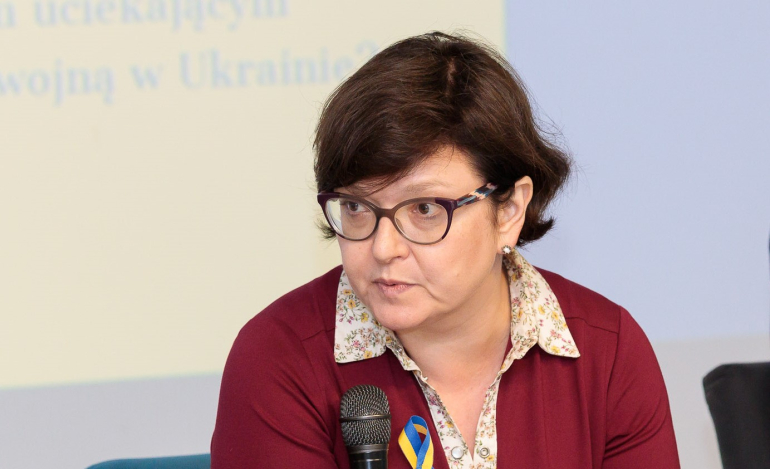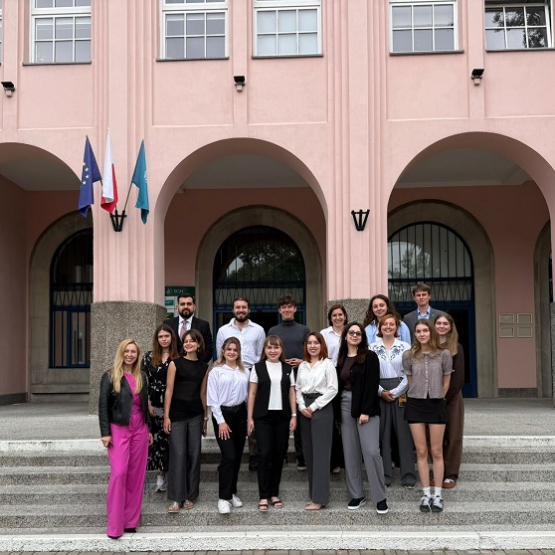Professor Agnieszka Chłoń-Domińczak on the job market following a mass flow of Ukrainian refugees to Poland

SGH Vice Rector for Research Agnieszka Chłoń-Domińczak on the job market following a mass flow of Ukrainian refugees to Poland. An author of one of the chapters of the latest report, “Hospitable Poland 2022+: How to effectively support Poland and the Poles in helping persons fleeing the war in Ukraine”, of which SGH is one of the partners, tells the Magazine of SGH Warsaw School of Economics about the migrants’ role, their demographic structure, qualifications and barriers they have to overcome to stay on the market.
Karolina Cygonek: Since 2014, following the Russian annexation of Crimea, the role of immigrants, notably Ukrainians, increased in the Polish job market. Let us take, for instance, the number of foreigners covered by social security in Poland. It is around 880 thousand (as of December 2021), with the Ukrainians as the majority. What has the Russian aggression of 24 February against Ukraine changed? How many more refugees came to the Polish job market?
Agnieszka Chłoń-Domińczak: Russia’a aggression against Ukraine caused mass migrations, both internal, as well as outside the country. Eleven million people are estimated to have left their homes. Around five million people left Ukraine for other countries, including 1.5 million who stayed in Poland, still, it is difficult to give the exact number. Over one million people have already applied for a PESEL number.
What is the demographic structure of the newcomers? What qualifications do they have?
It is mainly women with children that are coming to Poland. Men are not allowed to leave on account of the ongoing war. There are some seniors coming, but not many, because they do not like to leave their homes, even in the face of a risk associated with warfare. The people coming to Poland now are different from those coming earlier. Earlier on we had to do with a high share of men who worked in typically male job sectors, such as construction or transportation. On the other hand, we now have women coming who are often well educated, such as teachers or accountants, yet with no knowledge of the Polish language. These are different groups of people. They are looking for employment, they often engage in jobs below their qualifications. At the same time, some men who worked in Poland are going to Ukraine. So, what ensues is a job deficit in male-dominated sectors.
Will the migrants stay in Poland?
We do not know how many people will stay in Poland. According to the Ministry of Family and Social Policy, as many as over 150 thousand people have found a job thanks to the solutions provided by the special act, that is, special solutions enabling job centres to help to look for a job and simplifying any registration procedures.
What will happen in the future? To some extent, it depends on the war scenario. If the war ends sooner, we may expect some of the people will go back to their country, but then they may come to Poland again. Such was the case with the aftermath of the Crimean annexation when we had a steady flow of Ukrainian migrants, predominantly to the Polish job market. That was not just an on-and-off phenomenon. ZUS (Polish state Social Insurance Institution) data would show more and more people coming month by month, quarter by quarter. COVID-19 pandemic halted the process, but not for long.
It seems that we will be witnessing such a process of migrant influx for years to come. With dynamics somewhat lower than what we have seen so far. We must also remember that the Ukrainian population is not innumerable - the number of people who can come to Poland is not as high as before the war broke out. Still, I think we will be witnessing a steady migrant flux over the years to come.
The majority of newcomers are working below competence.
Right, for now, the people mostly do simple jobs. On the one hand, it is because the competence does not match the job market needs. On the other hand, it is a matter of language barrier. For instance, in order to do their job, teachers have to adhere to the Polish core curriculum. In the case of accountants or administrative workers, it is primarily the language command and communication that counts. It is language command that is one of the main barriers to being employed in line with qualifications.
A question remains: what will happen to our job market? If there is a deficit in typically male-dominated occupations, maybe it is a good idea for some women to requalify and take up such jobs. I have recently seen information on a female interior finishing firm established by female immigrants from Ukraine. It demonstrates that an increasing female engagement in construction, transportation or manufacturing is possible. It seems that the popularity of women (not only migrants) doing such jobs will be rising. Also, technological advances supporting work, especially labour, do their part.
What steps should be taken for migrants to do their jobs in line with competence?
Precisely “in line” may not be possible. For sure, we need language courses and training. Support understood as child care is also in very high demand. We have mothers of small children who came to Poland and the children simply need to be taken care of in nurseries, kindergartens and early classes of primary schools. Poland is becoming a multi-national and multi-cultural country and this concept has to be embraced. A need for a multi-cultural perspective has emerged. We also need training for Poles on how to function in a multi-cultural environment. It is vital for our job market to develop steadily and harmoniously. Certainly, we also need occupational training and courses designed to acquire competence related to the job you do.
Did you find it difficult to be working on this report?
It was a very fast process. We, the researchers, love being able to go deep into a subject, to adequately search for information and data. And here, we had to think of various areas and solutions in no time, because such were the circumstances. Definitely, the need for a fast response was the greatest challenge. At the same time, we wanted the report to follow a multidimensional reflection. We also wanted to point out clear potential courses of action as part of the recommendations. The rewarding part of working on this report was a multidisciplinary team. We would meet and discuss, present our analyses and reflections. That the report was being prepared by economists, psychologists, sociologists and medical doctors who could listen to what others think and present their vision was truly valuable. In this way, a very coherent report was written. I think it will be useful primarily for national and regional decision makers, as well as employers who can search it for a number of very practical recommendations on what can be done to actually best respond to the challenges of such a large share of Ukrainian visitors to Poland.



